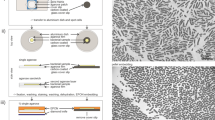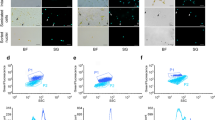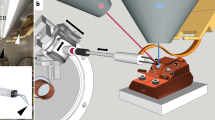Abstract
The nuclear matrix of diplomonad Giardia lambBa was detected for the first time with DGD embedment-sectioning-embedment free electron microscopy after a series of specific extractions. The result showed that archaezoa Giardia lamblia already possessed nuclear matrix within its two nuclei. The finest fibrils of the nuclear matrix of Giardia lamblia were measured to be about 11 to 13 nm in thickness. However, the nuclear lamina and nucleolus have never been observed. These results seem to suggest that nuclear matrix is an indispensable intranuclear structurM component even in the primitive nucleus.
Similar content being viewed by others
Introduction
Nuclear matrix has been known as an important intranuclear structure and plays significant roles in various nuclear activities, e.g. the duplication and transcription of DNA etc. However, almost all the studies concerning nuclear matrix were carried out on higher animal cells. Only recently, the nuclear matrix in protists has been studied mainly by two group of workers1, 2, 3. Up to now, the nuclear matrix of archezoa, the most primitive present-existing eukaryote, has never been reported. But in order to clarify the origin and early evolution of nucleus, the nuclear matrix and nuclear lamina of the most primitive unicellular eukaryotes ought to be studied. Therefore, we examined the nuclear matrix and nuclear lamina of an archezoan, Giardia lamina, a parasitic diplomonad. In all the diplomonads, each individual cell has two identical nuclei. There are few organelles in cytoplasm, but mitochondria an(t Golgi apparatus have never been found4.
Materials and Methods
Cell culture
Giardia lamblia strain was originally isolated by one of the authors (Siqi LU). The trophozoitea were cultivated at 37°C, in TYI-S-33 medium with some modifications and cultures usually reached their stationary phase after 2-3 d of growth.
Preparation of nuclear matrix
The adherent individual cells were made free with “ice bathing” method, collected and washed twice with ice cold PBS solution and then treated as described by5 with some modifications according to the physiological characteristics of G lamblia. Cell pellets were first extracted for 6-8 min at 4°C in Cytoskeletal (CSK) buffer containing 10 mM PIPES, 100 mM KCl, 300 mM Sucrose, 1 mM EGTA, 1.2 mM PMSF and 0.5% Triton X-10G pH 6.8. Phospholipids and soluble proteins were extracted at this step. The cells were then further extracted with RSB-Magik solution(42.5 mMTris-HCl, pH 7.4, 8.5 mM NaC1, 2.6 mM MgCl2, 1.2 mM PMSF, 1% Tween-40, 0.5% NP-40) for 6-8 min at 4°C The pellets were then washed twice with a digestion buffer containing 10 mM PIPES, 50 mM NaCl, 50 mM KCl, 3 mM MgCl2, 300 mM sucrose, 1 mM EGTA, 1.2 mM PMSF, and then DNase I was added to a final concentration of 300μg/ml. Digestion was carried out for 1 h at room temperature. Then (NH4)2SO4 was added to 0.25 M to terminate DNase digestion and DNA fragments and histones were removed from the cells. The nuclear matrix-intermediate filament-containing pellets were then processed for electron microscopy.
Electron microscopy
Materials were fixed in 2.5% glutaradehyde in CSK buffer for 50 min at 4°C, washed with 0.1 M Na-cacodylate buffer (pH 7.2) and then postfixed with 1% OsO4 in same buffer. The double fixed materials were washed with caeodylate buffer again and dehydrated through an ethanol series. Then the samples were transferred though n-butanol/ethanol mixture to n-butanol and then through a series of mixtures to the embedding medium DGD (diethylene glycol distearate) at 60°C. The DGD blocks were cut into sections (about 800–1000 °A). The sections were picked up on formvar-coated copper grids, and DGD was removed by immersing the grids in n-butanol for three times. Then, the grids were transferred into 100% ethanol, dried with critical-point drying method, and examined on a Hitachi H-300 electron microscope.
A small part of samples were embedded with Epon 812, ultrasectioned and stained as routine.
In order to measure the thickness of the thinnest fibrils of the nuclear matrix, we used the auto venier callipers (Japan made) and measured the thinnest fibrils in the electron photograph.
Results
As in other diploinonads, each individual cell of Giardia lamblia has two identical nuclei. There are few cell organelles in cytoplasm, but without mitochondria and Golgi apparatus. In several species of Giardia genus chromatin concentrated to form a centrally located chromatin sphere, which had been mistaken as Giardia nucleolus in very early literature. In conventional ultrathin sections both mlclei of Giardia were surrounded with prominent perinuclear space between the outer and inner nuclear membrane. But in some cases, we found that the nuclear envelope seemed to have large openings. Dense aggregate of heterochromatin, which would be mistaken for nucleolus, was occasionally observed. The nucleolus has never been observed in any conventional ultrathin sections of Giardia lamblia.
In DGD embedment-free sections of all unextracted Giardia cells, two nuclei can be seen, and a stereoscopic fibrillar network existed both in nucleus and cytoplasm, because the section was thicker (about 800–1000 51) than the section of conventional ultrathin section. There was a nuclear envelope existed as an electron dense area between the Giardia nucleus and its cytoplasm, but the inner and outer nuclear membrane could not be distinguished, nor the perinuclear space (Fig 1). The nuclear network of unextracted cells was connected with the network of cytoplasm to form a continuous network in the whole cell of Giardia. In such DGD -embedment free sections of the unextracted cells, the cytoplasm membrane often appeared thicker than that observed in conventional ultrathin section.
When Giardia cells were extracted with CSK solution prior to fixation, the soluble proteins and various membrane components, such as nuclear envelope, were all removed. In DGD embedment-free sections of these cells, the intranuclear network could still be seen, which was continuous with the fibrillar system within cytoplasm. Then an extraordinary thing was noticed that nuclear lamina has never been observed. Therefore, the distinct boundary between nucleus and cytoplasm was absent. Dense heterochromatin aggreates could still be occasionally observed.
When CSK-extracted cells were further extracted with RSB-Magik solution before fixation to further remove other soluble components, the intranuclear network was remained still in the DGD-embedment free sections; but the thickness of the fibrils seemed to become somewhat thinner. The intermediate filaments still existed in cytoplasm and connected with intranuclear network.
When the double extracted cells were further treated with DNase and with 0.25 M (NH4)2SO4 before fixation, heterochromatin aggregates all disappeared. This fact indicated that the aggregate was not the nucleolus of Giardia. In other unpublished works performed in our laboratory, with methyl green-pyronin staining for demonstrating DNA and RNA and bismuth staining6 for specifically demonstrating nucleolus, no nucleolus could be detected in Giardia nucleus. In the DNas treated DGD embedment-free sections, the intranuclear network still existed and was proved to be the nuclear matrix (Fig 1). It was still continuous with the filameats in cytoplasm. The nucler and cytoplasm regions could still be distinguisable. Using auto venier capllipers (Japan made), the thickness of the thinnest fibrils of the nuclear matrix was mearsured to be 11 to 13 nm.
Discussion
Archezoa are the most primitive present-existing eukaryotes4. Therefore, their nucleus may express some characteristics of the primitive nucleus. The nucleus of Giardia lamblia, a parasitic archezoan, was investigated in the present work. The dense aggregates of heterochromatin of Giardia lamblia, which might be mistaken as nucleolus, could occasionally be observed in nucleus of Giardi lamblia, but disappeared after DNase digestion. In the nuclei of Giardia muris no nucleolus was found in conventional ultrathin sections under electron-microscope7. The cytochemical work done by Russian scientist did not find any RNA-rich nucleolus-like body in the nuclei of Giardia duodenalis8. Our unpublished cytochelnical studies of Giardia muris with methyl green-pyronin staining and of Giardia lamblia with bismuth technique both gave negative results for the presence of uucleolus-like structure in their nuclei. The above results, taken together indicated that although Giardia nucleus possesses rDNA which has been isolated by Boothroyd, et al9, nucleolus has not yet been formed in the evolutionary history of Giardia. In a few species of microsporidia, another group of arachezoa, the nucleolus-like structures were reported10, 11 but there was no evidence to confirm that they are really true nucleoli.
In this paper, we have demonstrated for the first time the presence of nuclear matrix in Giardia lnmblin nucleus, through DGD embedding and embedment free electron microscopy after a series of specific extractions. Recently, Jian-fan WEN in our laboratory also found that nuclear matrix existed in the Giardin lamblia nucleus with whole mount electron microscopy after a series of specific extractions. Nuclear matrix has been known participating in a series of most important nuclear activities12, 13. The present work shows that the matrix has already existed even in archezoan nucleus. This finding suggested that nuclear matrix might be one of the indispensable structural components of the primitive nucleus just as nuclear envelope and chromosomes. This is important in understanding the origin and early evolution of cell nucleus and of eukaryotic cells.
Although nuclear matrix is already present in Giurdia nucleus, nuclear lamina has not been observed. However, whether nuclear lalnina is really absent in Giardia nucleus, is still a matter of major concern, two possibilities have to be considered. One possibility is that it is really absent and this absence represents a very primitive characteristics. The another is that the nuclear lamina is very primitive and is so fragile and weak that it can not bear the extraction procedures used in the present work.
References
Wen JF, Wu CF, Li JY . The nucleoskeleton of special dinoflagellate, oxyrrhis marina. Zoological Res 1992; 13:89–94.
Cai ST, Zeng CM, Li JY, Zhai ZH . Identification of the nuclear matrix and chromosomal scaffold in dinoflagellate Crypthecodinium cohnii. Cell Res 1992; 2:165–82.
Fang ZL, Wu CF, Li JY . The study on the nuclear matrix and its reality of Amphidinium carterae. Zoological Res 1993; 14:80–5.
Cavalier-smith T . Eukaryotic Evolution. In: XIV International Botanical Congress 1989: P 203–23.
Fey EG, Krochmalnic G, Penman S . The nonchromatin matrix of nucleus:Protein and DNA components revealed by sequential fractionation and resinless TEM section. J Cell Biol 1986; 98:1878–85.
Locke M . Bismuth staining for light and electron microscopy. Tissue and Cell 1977; 9:347–71.
Friend DS . The fine structure of Giardia muris. J Cell Biol 1966; 29:317–32.
Soloviev MM . Cytochemical study of Lamblia duodenalis. Medizin Parasitoli Parasit bolezni (Moscow) 1963: 675–8. (in Russian)
Boothroyd, JC et al. An unusual compact rDNA repeat in the protozoan Giardia lamblia. Nucl Acids Res 1987; 15:4065–84.
Canning, EU, Gunn A . Nosema helminthorum Moniez, 1887 (Microspora, Nosematidae): A Taxonomic Enigma. J Protozool 1984; 31:525–31.
Xie WD, Canning EU . Pyrotheca hydropsycheae N.Sp., a microsporidian parasite of caddis fly larvae, hydropsyche siltalai dohler, 1963 (Trichoptera, hydropsychiae). J Protozool 1986; 33:462–7.
Vaughn JP . Dijkwel PA Mullenders LHF, Hamlin JL . Replication forks are associated with the nuclear matrix. Nucl Acids Res 1990; 18:1965–9.
Adorn JN, Foy HR . A region immediately adjacent to the origin of the replication of bovine papilloma virus type I interact in vitro with the nuclear matrix. Biochem Biophys Res Commun 1991; 176:479–85.
Author information
Authors and Affiliations
Additional information
*Supported by Chinese National Foundation For Natural Science.
Rights and permissions
About this article
Cite this article
Dai, J., Li, J. & Lu, S. The detection of nuclear matrix in most primitive present- existing eukaryote, Giardia lamblia. Cell Res 5, 273–278 (1995). https://doi.org/10.1038/cr.1995.26
Received:
Revised:
Accepted:
Issue Date:
DOI: https://doi.org/10.1038/cr.1995.26





